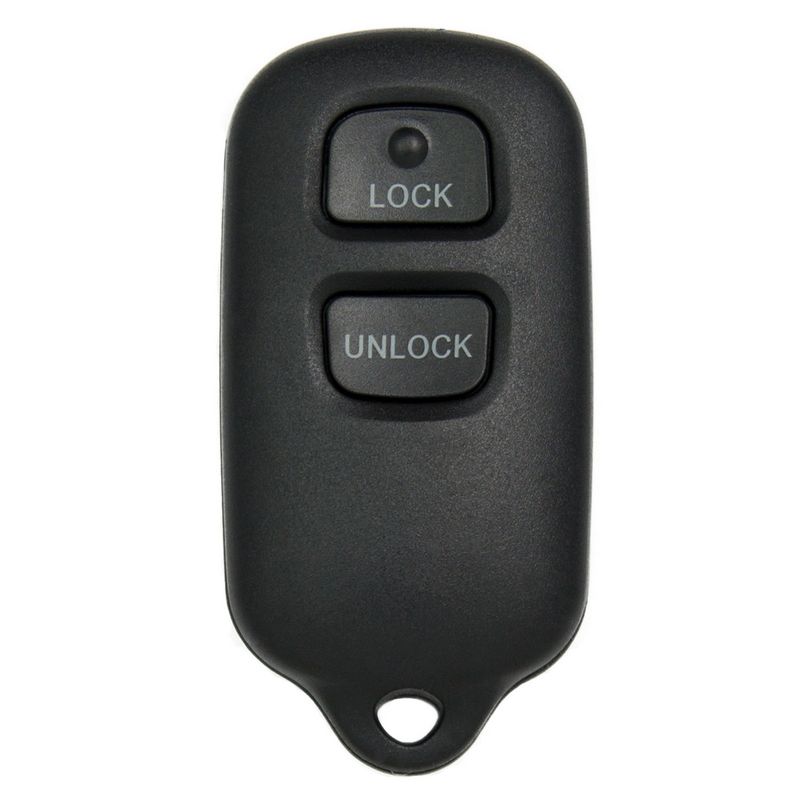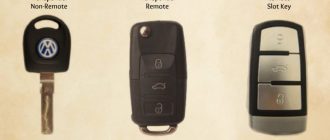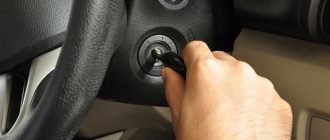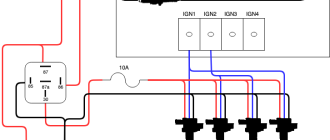
Car Key Remote And How It Works
A car key remote is a small device that allows you to conveniently lock or unlock your car with just the press of a button. But have you ever wondered how this tiny device actually works?
The key remote contains a transmitter and a receiver. When you press a button on the remote, it sends out a signal through radio waves. The receiver, which is installed in your car, picks up this signal and processes it.
The signal sent by the remote is encrypted, which means it is coded in such a way that only your car’s receiver can understand it. This prevents anyone with a similar remote from accessing your car.
Once the receiver in your car receives the signal and verifies its authenticity, it activates the lock or unlock mechanism accordingly. This is usually done by sending a signal to the central locking system of the car, which in turn locks or unlocks all the doors.
It’s important to note that car key remotes work within a limited range. This means that you need to be within a certain distance from your car for the remote to function properly. The range can vary depending on factors such as the model of the car and the environment.
In conclusion, a car key remote is a handy device that uses radio waves to send encrypted signals to your car’s receiver, allowing you to lock or unlock your car with ease. Understanding how it works can help you appreciate the convenience it offers and ensure its proper functioning.
Understanding the Basics
A car key remote is a device that allows you to control certain functions of your vehicle wirelessly. The remote works by emitting a signal that is received by the car’s receiver, allowing it to perform specific actions. It is usually referred to as a key fob or a keyless entry remote.
The remote is designed to make it more convenient for the driver to interact with their car. It typically has buttons that can lock and unlock the doors, open the trunk, and even start the engine from a distance. This eliminates the need to physically insert a key into the lock or ignition.
The key fob communicates with the car through a technology called radio frequency (RF) communication. When a button is pressed, the remote sends a coded signal via RF waves. The car’s receiver, located inside the vehicle, captures this signal and verifies its authenticity. Once the signal is authenticated, the receiver triggers the corresponding action, such as unlocking the doors.
The security of the key fob is ensured through the use of encryption. The coded signal is generated using a unique identifier specific to your remote and vehicle. This prevents unauthorized access and ensures that only your remote can control your car.
In addition to its convenience and security features, the key fob also incorporates a small battery that powers its operation. This battery needs to be periodically replaced to ensure the remote’s functionality.
Overall, the car key remote is an essential component of modern vehicles, providing a convenient and secure way to interact with your car without the need for physical keys.
Radio Frequency Technology
The car key remote uses radio frequency (RF) technology to communicate with the car’s control unit. This technology allows the remote to send signals wirelessly to the car, allowing the user to perform various functions such as locking and unlocking the car doors, opening the trunk, and activating the car’s alarm system.
The car key remote consists of two main components: the transmitter and the receiver. The transmitter is built into the remote itself and is responsible for sending the RF signals. The receiver, on the other hand, is located inside the car and receives the signals sent by the remote. When the receiver detects a valid signal, it activates the corresponding function in the car.
The remote and the car’s receiver communicate using a specific radio frequency, which is often in the range of 315 MHz or 433.92 MHz. These frequencies are chosen because they offer a good balance between range and power consumption. Additionally, the use of RF technology ensures that the car key remote can work even if there are obstacles between the remote and the car, such as walls or other vehicles.
To ensure secure communication between the remote and the car, modern car key remotes often use advanced techniques such as rolling codes. Rolling codes are a type of encryption that changes with each use of the remote. This makes it extremely difficult for an attacker to intercept and reproduce the RF signal, providing an extra layer of security for the car.
Overall, the use of radio frequency technology in car key remotes has greatly improved the convenience and security of operating a car. With just a push of a button, users can effortlessly control various functions of their car, making it a key accessory for modern car owners.
Transmission and Reception
One of the most important functions of a car key remote is its ability to transmit and receive signals. When you press a button on your key remote, it sends a signal to your car’s receiver, which is typically located in the interior of the vehicle. This signal contains a unique code that identifies your key and is used to unlock or lock your car’s doors, as well as perform other functions such as opening the trunk or sounding the alarm.
The transmission process begins when you press a button on your key remote. Inside the remote, there is a small electronic circuit that generates a radio frequency signal. This signal is then amplified and sent out through the key’s antenna. The antenna acts as a conductor, allowing the signal to travel through the air.
On the car’s end, the receiver picks up the signal sent by the key remote’s antenna. The receiver is capable of capturing and decoding the radio frequency signal. It then sends the decoded signal to the car’s central locking system, which processes the information and initiates the appropriate action, such as locking or unlocking the doors.
It’s important to note that the transmission and reception process happens very quickly, usually in a matter of milliseconds. This allows for seamless and immediate communication between the key remote and the car, ensuring that you can quickly and conveniently access your vehicle.
Encryption and Security Features
The car key remote operates on a secure encryption system to ensure the safety and security of your vehicle. This encryption technology uses advanced algorithms to encode the signals sent between the car and the remote. This makes it extremely difficult for unauthorized individuals to intercept and decode the signals.
Additionally, car key remotes often incorporate rolling codes, which add an extra layer of security. Rolling codes are unique, randomly generated codes that are transmitted between the car and the remote each time they communicate. This means that even if someone were able to intercept and decode a signal, they would not be able to use it to gain unauthorized access to the car because the code would have already changed.
Another security feature commonly found in car key remotes is the inclusion of a unique identifier. This identifier is programmed into the remote and paired with the car’s electronic system. This ensures that only the programmed remote can send and receive signals with the car. If a remote without the correct identifier is used, the signal will be ignored by the car’s system.
In addition to these encryption and security features, car key remotes often have built-in security measures like signal jamming detection. This feature can detect if a signal is being jammed or interfered with and will alert the car owner by sounding an alarm or flashing the car’s lights.
Overall, encryption and security features in car key remotes help to protect against unauthorized access and theft. These features ensure that only the owner of the key remote can control and access their car, providing peace of mind and added security.
Signal Range and Interference
The signal range of a car remote is an important factor in how it works. Typically, the range can vary from several feet to several hundred feet, depending on the technology used and any potential interference.
The car remote sends out a coded radio frequency signal to the receiver in the car. This signal is what allows the remote to communicate with the car and perform functions like locking or unlocking the doors, activating the alarm, or starting the engine.
Interference can affect the signal range of a car remote. Interference can come from various sources, such as other electronic devices, buildings, or even natural barriers like hills or trees. The presence of interference can weaken the signal and reduce the remote’s range.
To minimize interference, car remote systems often use a specific frequency band that is less prone to interference. Additionally, some car remotes may use advanced technologies like frequency hopping or rolling code systems to further enhance security and minimize the impact of interference.
Overall, the signal range and interference play a crucial role in how a car remote works. By understanding the factors that affect signal range and taking steps to reduce interference, car owners can ensure that their remote functions reliably and efficiently.
Battery Power and Replacement
The car key remote works by using a small battery to generate power. This battery is usually a lithium-ion or similar type of battery, which is small and long-lasting.
Over time, the battery in the key remote may start to lose its power. This is typically indicated by the remote not working as effectively or having a reduced range. When this happens, it is necessary to replace the battery.
To replace the battery, you will need to open the key remote using a small screwdriver or a coin. Inside, you will find the old battery, which can be easily removed and replaced with a new one of the same type. It is important to ensure that the battery is installed correctly, with the positive and negative terminals aligned correctly.
Once the new battery is in place, you can reassemble the key remote and test it to ensure that it is working properly. If the remote still does not work despite having a new battery, it may be necessary to troubleshoot or seek professional assistance.
Programming and Syncing
To make sure the car key remote works with your specific car, it needs to be programmed and synced. Programming involves installing the correct software or code onto the remote, while syncing refers to the process of matching the remote with your car’s security system.
Typically, the programming and syncing process is performed by a professional, such as a car dealer or locksmith. They have the necessary tools and knowledge to complete this task accurately and securely.
During the programming process, the key remote is connected to a computer or programming device. The software or code required for your car is then installed onto the remote. This allows the remote to send the correct signals to your car’s security system.
Once the remote is programmed, syncing it with your car’s security system is the next step. This process is usually done by following a specific sequence of actions, as outlined in the car’s manual or provided by the professional during the programming process.
Syncing involves pressing a series of buttons on the key remote while being in close proximity to your car. This allows the remote to communicate with your car’s security system and establish a connection.
Successfully programming and syncing your car key remote ensures that it can effectively communicate with your car’s security system, allowing you to lock and unlock the car, open the trunk, and activate the alarm system. It is essential to ensure that both the programming and syncing processes are performed correctly to avoid any issues with the functionality of your car key remote.
Different Types of Car Key Remotes
There are several different types of car key remotes that are used to lock and unlock a car. These remotes often come in the form of a small device that can be easily carried on a keychain. Here are some of the most common types of car key remotes:
- Traditional remote key fob: This type of remote uses a series of buttons to lock and unlock the car, as well as open the trunk and activate the panic alarm. The buttons on the remote are typically labeled with icons that represent each function.
- Keyless entry remote: This type of remote allows you to unlock the car without using a physical key. Instead, you simply press a button on the remote to unlock the doors. Some keyless entry remotes also have additional features, such as starting the car remotely.
- Smartphone app: Some car manufacturers now offer smartphone apps that can be used as a remote control for the car. These apps often allow you to lock and unlock the car, start the engine, and even locate the car using GPS.
Overall, car key remotes have become an essential accessory for car owners, providing convenience and added security. With advances in technology, the different types of car key remotes continue to evolve, offering even more features and functionality.
Advantages and Disadvantages
The car key remote offers several advantages and disadvantages for car owners. Understanding these can help you decide if using a remote key is the right choice for you.
Advantages:
1. Convenience: The remote key allows you to lock and unlock your car from a distance, providing convenience and ease of use. You no longer have to manually insert the key into the car’s lock.
2. Increased Security: The remote key uses a unique encryption code that makes it difficult for thieves to replicate. This enhances the security of your car by preventing unauthorized access.
3. Deterrent to Theft: The presence of a remote key can deter potential thieves from attempting to break into your car. The visible remote may signal that the car has advanced security features in place.
4. Remote Start Feature: Many remote keys come with a remote start feature that allows you to start your car’s engine from a distance. This can be especially useful during cold winters or hot summers, as you can warm up or cool down your car before getting inside.
Disadvantages:
1. Battery Dependency: The remote key relies on a battery to function. If the battery dies, you will not be able to use the remote features and may have difficulty accessing your car.
2. Higher Cost: Remote keys can be more expensive to replace compared to traditional keys. If you lose or damage your remote key, you may need to spend a significant amount to get a new one.
3. Vulnerability to Hacking: While remote keys provide enhanced security, they are not immune to hacking. Skilled hackers may be able to intercept and replicate the remote signal, allowing them to gain access to your car.
4. Limited Range: The remote key has a limited range within which it can communicate with the car’s locking system. If you are outside this range, the remote features may not work.
Considering the advantages and disadvantages can help you make an informed decision about using a car key remote for your vehicle.
Evolution of Car Key Remotes
The car key remote has come a long way since its inception. Originally, car keys were simple metal objects used to unlock and start a vehicle. However, with advances in technology, the traditional car key has evolved into a remote control device.
Early car key remotes were often bulky and required direct line-of-sight with the vehicle. They used infrared signals to communicate with the car’s locking mechanism. While effective, these remotes had limited range and were susceptible to interference from obstacles and other infrared signals.
As technology continued to advance, car key remotes transitioned to radio frequency (RF) signals. These remotes operate on a specific frequency and can communicate with the vehicle from a greater distance. RF remotes improved the convenience and functionality of car keys, allowing drivers to unlock or lock their vehicles from a distance and even start the engine remotely.
Modern car key remotes have also incorporated more advanced features, such as keyless entry and push-button ignition. Keyless entry systems allow drivers to unlock their cars simply by being in close proximity to the vehicle, eliminating the need to physically press a button or insert a key. Push-button ignition systems eliminate the need for a physical key altogether, allowing drivers to start their vehicles with the push of a button.
Overall, the evolution of car key remotes has transformed the way we interact with our vehicles. From simple metal keys to sophisticated remote control devices, car key remotes have greatly enhanced convenience and security for drivers.
Common Issues and Troubleshooting
While car key remotes are generally reliable, there are some common issues that can occur. Here are a few troubleshooting tips:
1. Remote not working: If your car key remote stops working, check the battery first. It may need to be replaced. If the battery is not the issue, try reprogramming the remote. Refer to your car’s manual for instructions on how to do this.
2. Range issues: If you find that the range of your car key remote has decreased, there may be interference or an obstruction blocking the signal. Try getting closer to the car or standing in a different location to see if that improves the range.
3. Broken or damaged key: If the physical key or remote buttons are not working, it could be due to wear and tear. In this case, you may need to replace the key or remote. Consult with a professional locksmith or your car manufacturer for assistance.
4. Programming issues: If you’re having trouble programming a new remote or syncing it with your car’s system, double-check that you are following the correct steps outlined in the manual. If you’re still experiencing issues, it may be best to seek help from a professional.
5. Lost or stolen key: If you have lost your car key remote or it has been stolen, there are a few steps you should take. First, contact your car manufacturer to see if they can provide a replacement remote. Additionally, consider having your car rekeyed or reprogrammed to ensure that the lost key cannot be used to gain access to your vehicle.
Remember, when in doubt, it’s always a good idea to seek assistance from a professional locksmith or your car’s manufacturer. They will have the expertise and resources to help you troubleshoot and resolve any issues with your car key remote.
Alternatives to Car Key Remotes
If you’re looking for alternatives to car key remotes, there are a few options available. While car key remotes have become the standard for many modern vehicles, there are other ways to access and start your car.
One alternative is using a traditional key. This may seem old-fashioned, but it’s still a reliable and common method to access and start a car. With a traditional key, you simply insert it into the car’s door lock or ignition and turn it to unlock or start the car.
Another alternative is using a key card or key fob. Similar to a car key remote, these devices use electronic signals to unlock and start your car. Key cards are usually flat and can be easily stored in a wallet or purse, while key fobs are typically small and can be attached to a keychain.
Some car manufacturers also offer mobile apps that can be used to lock, unlock, and start your car. These apps require a smartphone and a digital connection to your car. Once connected, you can use the app to remotely control your car’s functions.
Lastly, there are biometric options available for car access. This includes fingerprint recognition or facial recognition systems. These systems use advanced technology to identify and authenticate the car owner, allowing them to access and start their car with just their unique biological features.
While car key remotes are convenient and popular, there are various alternatives available that can suit different preferences and needs. Whether you prefer a traditional key, a key card or fob, a mobile app, or even biometric access, there are options to fit your lifestyle.
Remote Locking and Unlocking Mechanism
The key remote is an essential component of modern car technology. It enables drivers to conveniently lock and unlock their vehicles at a distance. This mechanism utilizes radio frequency technology to communicate with the car’s locking system.
When the driver presses the lock or unlock button on the key remote, a signal is sent to the car’s central locking system. This signal contains a unique code that is recognized by the car’s receiver. The receiver then processes the code and activates the corresponding function, either locking or unlocking the car.
The key remote works by transmitting the signal through an antenna located within the car key remote itself. This antenna is responsible for sending and receiving the radio frequency signal. The remote’s transmitter circuit is also equipped with a small battery, which powers the remote and enables it to send the signal to the car’s receiver.
Once the car’s receiver receives the signal, it decodes the unique code and activates the appropriate locking or unlocking mechanism. This mechanism may involve controlling the car’s central locking system or signaling the individual door locks to engage or disengage.
Overall, the key remote plays a crucial role in providing convenience and security for car owners. With the push of a button, drivers can remotely lock or unlock their cars, eliminating the need for manual key insertion and turning. This technology has become commonplace in modern cars, streamlining the process of accessing and securing vehicles.
Integration with Other Car Systems
The car key remote is an essential component that allows drivers to remotely operate their vehicles. It works by sending signals to the car’s central locking system, enabling the driver to lock or unlock the doors with just the press of a button.
However, the car key remote does not operate independently. It is integrated with various other car systems to provide a seamless user experience. One of the main integrations is with the car’s immobilizer system.
The immobilizer system is designed to prevent unauthorized access to the car. When the car key remote is used to unlock the doors, it sends a signal to the immobilizer system, which then disables the immobilizer and allows the engine to start.
Additionally, the car key remote is often integrated with the car’s alarm system. When the remote is used to unlock the doors, it also deactivates the alarm, ensuring a smooth entry into the vehicle.
The integration between the car key remote and the car’s electronics extends to features such as automatic engine start and climate control. Many car key remotes offer the option to start the engine remotely, allowing the driver to warm up or cool down the car before getting inside. This integration requires the car’s engine and climate control systems to be connected with the remote’s functionality.
Overall, the integration between the car key remote and other car systems enhances convenience and security for drivers. It allows for easy access to the car, disables the alarm system, and provides the ability to start the car remotely. These integrations make the car key remote a vital component in modern car technology.
Future Developments and Trends
As technology continues to advance, we can expect to see further developments and trends in how car key remotes work. One potential future development is the integration of remote control functionality into smartphones. With the increasing ubiquity of smartphones, it is conceivable that car manufacturers will design apps that allow users to control their vehicles remotely through their phones.
Another trend that we may see in the future is the use of biometric technology in car key remotes. Biometric authentication, such as fingerprint or iris scanning, could be used to ensure that only authorized individuals can use the remote to unlock and start the car.
Furthermore, car key remotes could become more intelligent and customizable. Artificial intelligence and machine learning technologies may be incorporated into the remote’s software, allowing it to learn the user’s preferences and adapt its functions accordingly. For example, the remote could learn the user’s preferred temperature settings and automatically adjust the car’s climate control system when the user approaches.
In addition to these developments, car key remotes may also become more compact and lightweight. Advancements in battery technology and miniaturization could allow for smaller and more efficient remotes. This would make them easier to carry and less cumbersome in everyday use.
Overall, the future of car key remotes looks promising. We can expect to see further integration with smartphones, the use of biometric technology, intelligent customization, and improved compactness. These advancements will undoubtedly enhance the convenience and functionality of remote car access.
Q&A:
How does a car key remote work?
A car key remote works by using radio frequency signals to communicate with the vehicle. When you press a button on the remote, it sends a signal to a receiver in the car, which then performs the desired action, such as unlocking the doors or starting the engine.
What is the purpose of a car key remote?
The purpose of a car key remote is to provide convenience and security to the vehicle owner. It allows you to lock or unlock your car doors or even start the engine from a distance, eliminating the need for a physical key.
How far can a car key remote work?
The range of a car key remote varies depending on the specific model and manufacturer. In general, most remotes can work within a range of 50 to 100 feet, allowing you to control your car from a reasonable distance.
Can a car key remote be easily hacked?
While it is technically possible for a car key remote to be hacked, it is not a common occurrence. Modern key remotes use encryption and rolling code technology to prevent unauthorized access. However, it is important to practice good security measures, such as keeping your remote safe and not leaving it in plain sight.
How do you program a car key remote?
The process of programming a car key remote varies depending on the make and model of your vehicle. In most cases, you will need to follow the instructions provided by the manufacturer or consult a professional locksmith or dealership. It typically involves a series of button presses and entering a specific code to synchronize the remote with your car’s system.
How does a car key remote work?
A car key remote works through radio frequency communication between the remote and the car’s receiver. When you press a button on the remote, it sends a coded signal to the receiver, which then unlocks or locks the car, disables the alarm, or performs other functions.






